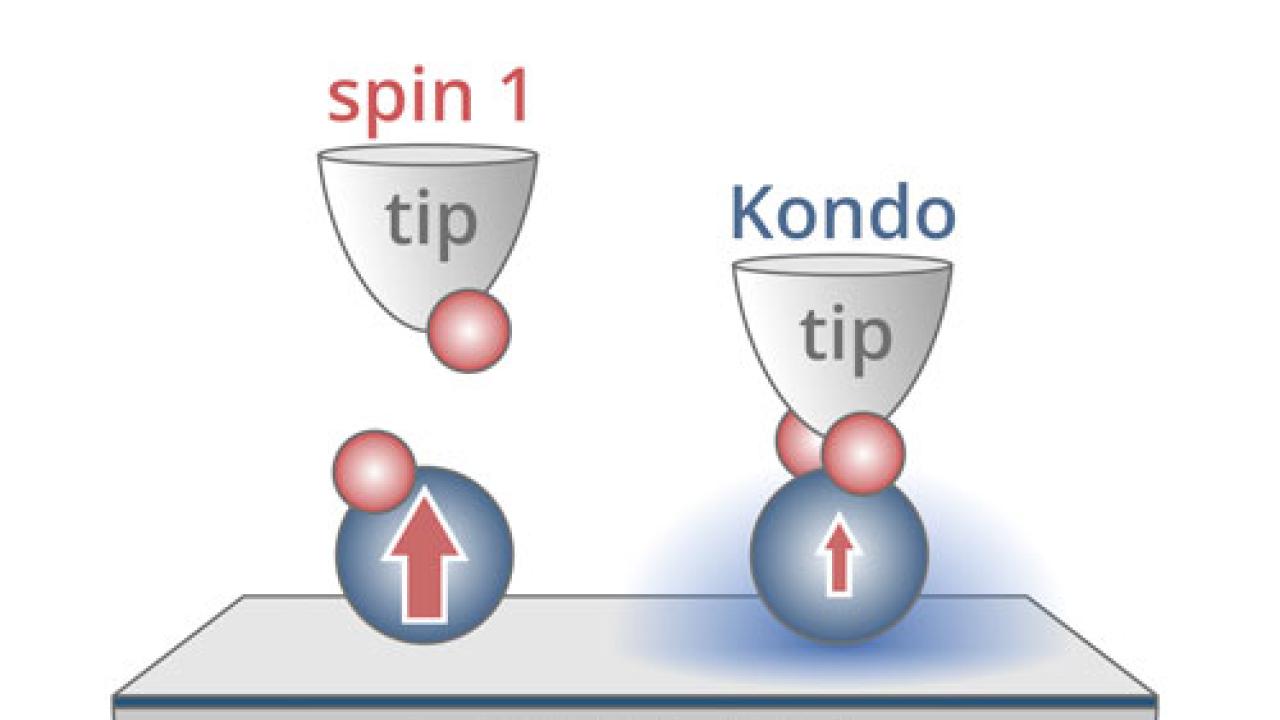
Electrons, those tiny elementary particles that help make up almost everything we know, come with spins. Spin is the intrinsic angular momentum in one of two directions, usually called up and down, and its presence creates a lot of the properties of matter that we're familiar with. Spins provide particles with magnetic moments, which interact with and influence, even in a very small way, the behavior of all the electrons and particles in their surroundings.
These interactions can get complicated quickly, and one example of such a complex interplay of spins, known as the Kondo effect, was the subject of investigations by a group of experimental physicists, including ICTP Postdoctoral Fellow Oleg Brovko, the results of which have been published in Science Advances (doi: 10.1126/sciadv.1602060).
Simply stated, the Kondo effect is a particular way in which electrons in a non-magnetic material behave when they encounter a magnetic impurity. Normally, the spins of electrons in a non-magnetic material randomly point up and down, with equal amounts of each. But the electrons in the vicinity of a magnetic impurity tend to huddle together and align with each other, with their spins pointing opposite to the impurity's spin. This behavior results in an unexpected increase in electrical resistance at very cold temperatures, the classical Kondo effect. The group dance of electrons creates what's known as the Kondo screening cloud, a cloud of electrons surrounding a magnetic impurity, 'screening' it by canceling out the impurity's magnetism with all of their counter-aligned spins. This is the behavior that the group wants to learn more about, along with what its implications for electron transport and how it might be controlled.
Materials scientists and physicists are interested in the spins of electrons, and they're not the only ones. Spins may have the potential to store information: where conventional computers are based on transistors which can only be in an on or off state, an atom or molecule's spin or combination of spins could possibly use many more state options to store information with, thus drastically increasing data storage density. Controlling individual spins, instead of flipping the spin directions of groups of particles with magnetic force, is one of the challenges of trying to use spins to store information. "The Kondo effect is likely to complicate any device or operation done at this scale," says Brovko. "To be able to understand it and possibly even harness it is key."
Tiny needles have already been used to reach in and flip the spin of only one particle, instead of the spins of a large group of particles. Those needles are used as tips for combined scanning tunneling and noncontact atomic force microscopes, which track both force and conductance. But the process of flipping only one spin gets more complicated when Kondo screening comes into play. When all the particles surrounding a magnetic impurity align their spins counter to that impurity's magnetic moment, the Kondo effect changes how electrons interact, travel, and behave.
Work on how to manipulate the Kondo effect has already started- it has been known for a few decades now that raising the temperature of the system destroys the coordination of the free electrons and the matching particle spins they create. This paper manages to manipulate the Kondo effect through another one of its properties: its sensitivity to the magnitude of the magnetic moment of the impurity. Changing the magnetic moment of the impurity could, in effect, turn the Kondo cloud on and off.
The research, for which Brovko collaborated with experimentalists working at the Max Planck Institute for Solid State Research, shows how a needle with a hydrogen atom at the tip could do just that. The researchers brought the tiny needle close to the magnetic impurity sitting in the surface of the non-magnetic material. When the hydrogen atom gets very close to the impurity, the two form a weak bond. That bond robs the impurity of a fraction of its magnetic moment, and its spin becomes small enough for the Kondo cloud to build up and screen the spin, counterbalancing any effect it might have. Draw the hydrogen atom on the microscope's tip away, and the bond breaks, the impurity's magnetic moment increases, and the Kondo cloud disperses.
This switching on and off of the Kondo effect provides a valuable proof-of-principle of Kondo effect control. "It also gives us valuable insight into the interplay of Kondo with the mechanical characteristics of the system," says Brovko. In the quest to use the spins of atoms or even the net spins of molecules to store information, having a tool like this could be very useful, as researchers understand more and more how the full ripple effects of Kondo clouds.
The paper, titled Potential energy–driven spin manipulation via a controllable hydrogen ligand, appeared in the 14 April 2017 edition of Science Advances.
-----Kelsey Calhoun
















